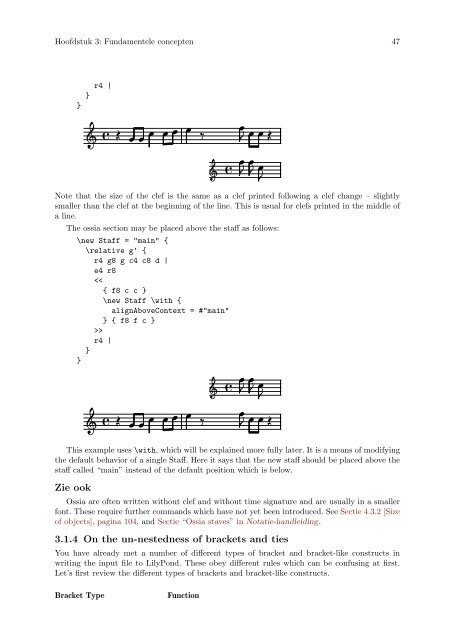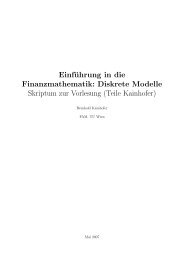LilyPond Beginnershandleiding
LilyPond Beginnershandleiding
LilyPond Beginnershandleiding
You also want an ePaper? Increase the reach of your titles
YUMPU automatically turns print PDFs into web optimized ePapers that Google loves.
Hoofdstuk 3: Fundamentele concepten 47<br />
}<br />
}<br />
r4 |<br />
<br />
<br />
<br />
<br />
<br />
<br />
<br />
<br />
<br />
<br />
<br />
<br />
Note that the size of the clef is the same as a clef printed following a clef change – slightly<br />
smaller than the clef at the beginning of the line. This is usual for clefs printed in the middle of<br />
a line.<br />
The ossia section may be placed above the staff as follows:<br />
\new Staff = "main" {<br />
\relative g' {<br />
r4 g8 g c4 c8 d |<br />
e4 r8<br />
><br />
r4 |<br />
}<br />
}<br />
<br />
<br />
<br />
<br />
<br />
<br />
<br />
<br />
<br />
<br />
<br />
<br />
This example uses \with, which will be explained more fully later. It is a means of modifying<br />
the default behavior of a single Staff. Here it says that the new staff should be placed above the<br />
staff called “main” instead of the default position which is below.<br />
Zie ook<br />
Ossia are often written without clef and without time signature and are usually in a smaller<br />
font. These require further commands which have not yet been introduced. See Sectie 4.3.2 [Size<br />
of objects], pagina 104, and Sectie “Ossia staves” in Notatie-handleiding.<br />
3.1.4 On the un-nestedness of brackets and ties<br />
You have already met a number of different types of bracket and bracket-like constructs in<br />
writing the input file to <strong>LilyPond</strong>. These obey different rules which can be confusing at first.<br />
Let’s first review the different types of brackets and bracket-like constructs.<br />
Bracket Type Function



